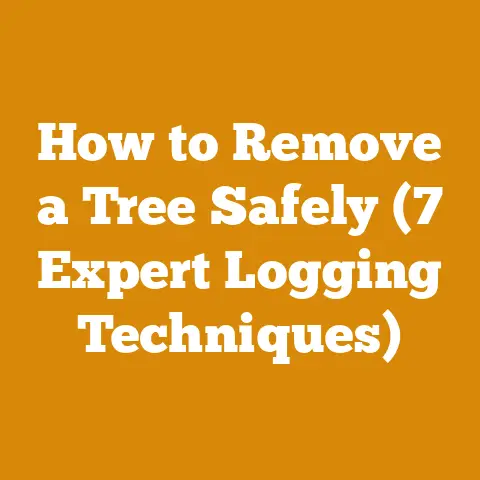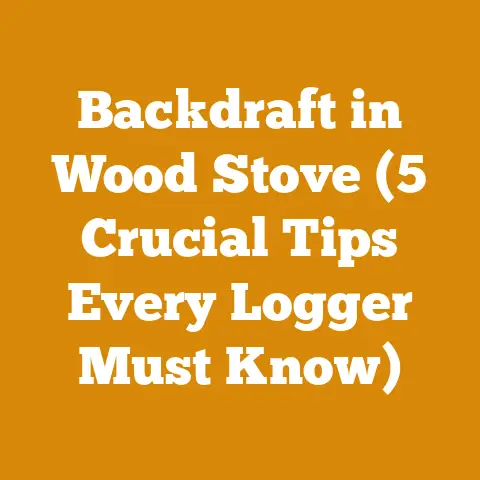Creosote Removal Tips (5 Pro Techniques for Cleaner Woodstoves)
Let’s face it, creosote is the silent enemy of every wood-burning stove owner. It builds up slowly, deceptively, and before you know it, you’re staring down the barrel of a chimney fire waiting to happen. Over the years, I’ve tackled creosote buildup in countless stoves and chimneys, learning a thing or two through trial, error, and a healthy dose of soot-covered mishaps. So, let’s get started with creosote removal tips.
Creosote Removal Tips (5 Pro Techniques for Cleaner Woodstoves)
Creosote isn’t just a nuisance; it’s a serious fire hazard. Understanding what it is, how it forms, and most importantly, how to remove it, is crucial for the safety of your home and family. I’m going to walk you through five pro techniques that I’ve personally used and refined over the years to keep woodstoves and chimneys clean and safe. These aren’t just theoretical ideas; they’re practical, actionable steps you can take today.
Understanding Creosote: The Chimney’s Silent Threat
Creosote is a byproduct of incomplete combustion in your wood stove. Think of it as unburned wood particles, gases, and moisture that condense inside your chimney flue. It’s a nasty, sticky substance that can range in color from brown or black to a shiny, glazed appearance.
Creosote formation is influenced by several factors:
- Wood Moisture Content: Burning wet or unseasoned wood is the biggest culprit. Wet wood doesn’t burn efficiently, leading to more smoke and creosote. I aim for a moisture content of 20% or less for my firewood. I use a moisture meter to test every batch.
- Air Supply: Restricted air supply leads to smoldering fires, which produce more smoke and creosote.
- Chimney Temperature: A cool chimney allows the smoke to condense more readily, forming creosote.
There are three stages of creosote:
- Stage 1 (Soot): This is a flaky, easily removable deposit. Regular cleaning can prevent it from progressing.
- Stage 2 (Tar): This is a sticky, granular deposit that’s harder to remove than soot.
- Stage 3 (Glazed Creosote): This is a hard, shiny, and extremely flammable deposit. It’s the most dangerous and difficult to remove.
Why is Creosote Dangerous?
Creosote is highly flammable. Even a thin layer can ignite and cause a chimney fire. Chimney fires can spread to your home, causing significant damage and endangering lives. According to the National Fire Protection Association (NFPA), chimney fires are a leading cause of residential fires in the United States, resulting in millions of dollars in property damage annually.
Takeaway: Creosote is a serious fire hazard that requires proactive prevention and removal. Understanding the factors that contribute to its formation is the first step in keeping your wood stove and chimney safe.
Technique 1: The Annual Chimney Sweep – A Pro’s Perspective
This isn’t just a suggestion; it’s a necessity. I recommend a professional chimney sweep at least once a year, even if you think you’re doing a good job on your own. They have the tools and expertise to thoroughly inspect and clean your entire chimney system.
Finding a Qualified Chimney Sweep:
- Certification: Look for a chimney sweep certified by the Chimney Safety Institute of America (CSIA). This certification ensures they’ve undergone rigorous training and adhere to industry standards.
- Insurance: Make sure they have liability insurance to cover any potential damage to your home.
- References: Ask for references from previous customers and check online reviews.
- Detailed Inspection: A good chimney sweep will perform a thorough inspection of your chimney, including checking for cracks, blockages, and other potential problems.
The Chimney Sweep Process:
A professional chimney sweep will typically use a variety of tools to clean your chimney, including:
- Chimney Brushes: These come in various sizes and shapes to fit different chimney flues. I’ve seen sweeps use everything from wire brushes for masonry chimneys to poly brushes for metal chimneys.
- Extension Rods: These allow the sweep to reach the entire length of the chimney.
- Vacuum: A powerful vacuum is used to remove the dislodged creosote and soot.
- Inspection Camera: This allows the sweep to visually inspect the chimney flue for cracks, blockages, and other problems.
My Personal Experience:
I once hired a chimney sweep who found a bird’s nest blocking my chimney flue. I had no idea it was there, and it could have caused a serious fire. This experience reinforced the importance of professional inspections.
Cost Considerations:
The cost of a chimney sweep can vary depending on the complexity of the job and your location. Expect to pay anywhere from $150 to $300 for a standard cleaning. While it may seem like a significant expense, it’s a small price to pay for the safety of your home.
Takeaway: Hiring a qualified chimney sweep for an annual inspection and cleaning is a crucial investment in your home’s safety. Don’t skimp on this service.
Technique 2: DIY Chimney Cleaning – Tools and Techniques I Use
While a professional sweep is essential, I also supplement with my own DIY cleaning efforts in between professional visits. This helps keep creosote buildup at bay and allows me to monitor the condition of my chimney.
Essential Tools for DIY Chimney Cleaning:
- Chimney Brush: Choose the right size and type of brush for your chimney flue. Measure the flue diameter and select a brush that’s slightly larger. For metal chimneys, use a poly brush to avoid scratching the metal.
- Extension Rods: Invest in a set of flexible extension rods that can be easily connected to reach the entire length of your chimney.
- Drop Cloths: Protect your flooring and furniture from soot and creosote. I use heavy-duty canvas drop cloths.
- Dust Mask and Safety Glasses: Protect yourself from inhaling soot and getting it in your eyes.
- Vacuum: A shop vacuum with a HEPA filter is essential for cleaning up the soot and creosote.
- Chimney Inspection Mirror: This allows you to visually inspect the chimney flue for creosote buildup and other problems.
- Creosote Remover: Chemical creosote removers can help loosen stubborn creosote deposits.
Step-by-Step DIY Cleaning Process:
- Preparation: Cover your flooring and furniture with drop cloths. Wear a dust mask and safety glasses.
- Access the Chimney: Remove the stovepipe from the wood stove and seal the opening to prevent soot from entering your home. Access the chimney from the top or bottom, depending on your chimney design.
- Brush the Chimney: Attach the chimney brush to the extension rods and push it up and down the chimney flue, overlapping each stroke. Apply firm, even pressure to remove the creosote.
- Vacuum the Soot: Use the shop vacuum to remove the dislodged soot and creosote from the bottom of the chimney.
- Inspect the Chimney: Use the chimney inspection mirror to visually inspect the chimney flue for any remaining creosote or problems.
- Reassemble the Stovepipe: Carefully reattach the stovepipe to the wood stove, ensuring a tight seal.
My DIY Cleaning Schedule:
I typically clean my chimney myself every 2-3 months during the heating season. This helps prevent excessive creosote buildup and allows me to catch any potential problems early.
Important Safety Precautions:
- Never clean your chimney during windy conditions.
- Always wear a dust mask and safety glasses.
- Be careful when working on the roof.
- If you’re not comfortable cleaning your chimney yourself, hire a professional.
Takeaway: DIY chimney cleaning can be a valuable supplement to professional chimney sweeps. However, it’s important to use the right tools, follow safety precautions, and know your limitations. If you’re not comfortable with the process, leave it to the professionals.
Technique 3: Burning Practices – Fuel and Fire Management
The way you burn wood has a direct impact on creosote formation. I’ve learned that proper burning practices are just as important as cleaning.
Burning Seasoned Wood:
Burning wet or unseasoned wood is the single biggest contributor to creosote buildup. Wet wood doesn’t burn efficiently, leading to more smoke and creosote.
- Moisture Content: Aim for a moisture content of 20% or less. I use a moisture meter to test my firewood.
- Seasoning Time: Firewood typically needs to season for at least 6-12 months, depending on the type of wood and climate.
- Storage: Store firewood in a dry, well-ventilated area, off the ground and covered.
Air Supply Management:
Restricting the air supply to your wood stove can lead to smoldering fires, which produce more smoke and creosote.
- Open the Air Vents: Ensure that the air vents on your wood stove are open enough to allow for proper combustion.
- Avoid Smoldering Fires: Don’t let your fire smolder for extended periods.
- Burn Hot Fires: Hot fires burn more efficiently and produce less creosote.
Top-Down Burning:
Top-down burning is a technique where you light the fire from the top instead of the bottom. This allows the fire to burn more cleanly and efficiently, reducing creosote buildup.
- Stack the Wood: Stack the larger pieces of wood at the bottom, followed by smaller pieces and kindling on top.
- Light the Kindling: Light the kindling at the top of the stack.
- Let it Burn Down: Allow the fire to burn down naturally, without adding more wood.
My Burning Routine:
I always start my fires with dry kindling and small pieces of wood. I gradually add larger pieces of wood as the fire gets going. I also make sure to open the air vents enough to allow for proper combustion. I prefer top-down burning whenever possible.
Wood Species and Creosote:
Some wood species are known to produce more creosote than others. Softwoods like pine and fir tend to produce more creosote than hardwoods like oak and maple. However, burning seasoned wood of any species is always better than burning wet wood.
Takeaway: Proper burning practices can significantly reduce creosote buildup in your chimney. Burn seasoned wood, manage the air supply, and consider using top-down burning techniques.
Technique 4: Chemical Creosote Removers – When and How to Use Them
Chemical creosote removers can be a helpful tool for loosening stubborn creosote deposits. However, they should be used with caution and as a supplement to, not a replacement for, regular chimney cleaning.
Types of Chemical Creosote Removers:
- Powdered Creosote Removers: These are sprinkled on the fire and release chemicals that help break down the creosote.
- Liquid Creosote Removers: These are sprayed into the firebox or chimney flue and work in a similar way to powdered removers.
- Creosote Removing Logs: These logs are burned in the wood stove and release chemicals that help break down the creosote.
How Chemical Creosote Removers Work:
Chemical creosote removers work by chemically altering the creosote, making it less flammable and easier to remove. They can also help to dry out the creosote, making it more brittle and easier to sweep away.
When to Use Chemical Creosote Removers:
- Between Professional Cleanings: Use chemical creosote removers between professional chimney cleanings to help keep creosote buildup at bay.
- After Burning Wet Wood: If you accidentally burn wet wood, use a chemical creosote remover to help loosen any creosote deposits that may have formed.
- Before a Chimney Sweep: Using a chemical creosote remover before a professional chimney sweep can help make the cleaning process easier.
How to Use Chemical Creosote Removers:
- Follow the Manufacturer’s Instructions: Always follow the manufacturer’s instructions carefully.
- Use the Right Amount: Don’t use too much or too little of the product.
- Apply Regularly: Apply the product regularly, as directed by the manufacturer.
- Ventilate the Area: Ensure that the area is well-ventilated when using chemical creosote removers.
My Experience with Creosote Removers:
I’ve used powdered creosote removers in the past and found them to be helpful in loosening stubborn creosote deposits. However, I always make sure to follow the manufacturer’s instructions carefully and to use them in conjunction with regular chimney cleaning.
Potential Risks of Chemical Creosote Removers:
- Incomplete Removal: Chemical creosote removers may not completely remove all of the creosote.
- Corrosion: Some chemical creosote removers can be corrosive to metal chimney flues.
- Fire Hazard: If used improperly, chemical creosote removers can actually increase the risk of a chimney fire.
Takeaway: Chemical creosote removers can be a helpful tool for loosening stubborn creosote deposits, but they should be used with caution and as a supplement to, not a replacement for, regular chimney cleaning. Always follow the manufacturer’s instructions carefully and be aware of the potential risks.
Technique 5: Regular Inspections – Catching Problems Early
Regular inspections are key to preventing creosote buildup and identifying potential problems before they become serious. I make it a habit to visually inspect my wood stove and chimney regularly.
What to Look For During Inspections:
- Creosote Buildup: Check for creosote buildup in the stovepipe and chimney flue. Look for signs of excessive soot, tar, or glazed creosote.
- Cracks and Damage: Inspect the chimney for cracks, damage, or deterioration. Pay close attention to the chimney crown, brickwork, and flue liner.
- Blockages: Check for blockages in the chimney flue, such as bird’s nests, leaves, or other debris.
- Stovepipe Connections: Ensure that the stovepipe connections are tight and secure.
- Stove Condition: Inspect the wood stove for cracks, damage, or other problems.
Inspection Frequency:
- Monthly Inspections: I recommend a visual inspection of the stovepipe and firebox at least once a month during the heating season.
- Annual Inspections: A professional chimney inspection is essential at least once a year.
Tools for Inspections:
- Flashlight: A bright flashlight is essential for inspecting the chimney flue.
- Chimney Inspection Mirror: This allows you to visually inspect the chimney flue for creosote buildup and other problems.
- Camera: Take photos of any potential problems to document them and show them to a professional chimney sweep.
My Inspection Routine:
I start by visually inspecting the stovepipe and firebox for creosote buildup. Then, I use a flashlight and chimney inspection mirror to inspect the chimney flue. I also check the chimney exterior for cracks, damage, and blockages.
Addressing Potential Problems:
- Minor Creosote Buildup: If you find minor creosote buildup, you can try cleaning it yourself using a chimney brush and vacuum.
- Significant Creosote Buildup: If you find significant creosote buildup, it’s best to call a professional chimney sweep.
- Cracks or Damage: If you find cracks or damage to the chimney, it’s important to have it repaired by a qualified professional.
- Blockages: Remove any blockages from the chimney flue as soon as possible.
Takeaway: Regular inspections are essential for preventing creosote buildup and identifying potential problems before they become serious. Make it a habit to visually inspect your wood stove and chimney regularly, and schedule a professional chimney inspection at least once a year.
Beyond the Basics: Advanced Creosote Management
While the five techniques I’ve outlined are foundational, there are a few more advanced strategies I’ve employed over the years to further minimize creosote buildup.
Catalytic Combustors:
If your wood stove is compatible, consider installing a catalytic combustor. These devices significantly reduce smoke emissions and creosote formation by burning off unburned gases and particles. I’ve seen stoves with combustors produce noticeably less creosote compared to non-combustor models.
Monitoring Flue Temperatures:
Investing in a flue thermometer allows you to monitor the temperature of your chimney. Maintaining a proper flue temperature (generally between 250°F and 500°F) ensures efficient combustion and reduces creosote formation. Too low, and you’re creating creosote. Too high, and you’re wasting fuel and potentially damaging your chimney.
Choosing the Right Wood Stove:
When selecting a wood stove, research models known for their clean-burning capabilities. EPA-certified stoves are designed to burn more efficiently and produce less smoke and creosote.
Insulated Chimney Liners:
If you have an older chimney, consider installing an insulated chimney liner. Insulated liners help maintain a consistent flue temperature, reducing condensation and creosote formation.
Dealing with Glazed Creosote:
Glazed creosote is the most challenging type to remove. If you suspect you have glazed creosote, it’s crucial to consult with a professional chimney sweep. They may use specialized tools like rotary loops or chemical treatments to break down the hardened creosote.
Takeaway: Advanced strategies like catalytic combustors, flue temperature monitoring, and insulated chimney liners can further minimize creosote buildup and improve the overall efficiency and safety of your wood-burning system.
Common Mistakes to Avoid
Even with the best intentions, it’s easy to make mistakes that can contribute to creosote buildup. Here are some common pitfalls I’ve seen and learned to avoid:
- Burning Trash or Treated Wood: Never burn trash, treated wood, or painted wood in your wood stove. These materials release harmful chemicals and can contribute to creosote formation.
- Overloading the Firebox: Overloading the firebox can restrict airflow and lead to smoldering fires, which produce more smoke and creosote.
- Closing the Air Vents Too Early: Don’t close the air vents too early in the burning process. Allow the fire to burn hot and efficiently before reducing the air supply.
- Ignoring Warning Signs: Pay attention to warning signs of creosote buildup, such as excessive smoke, a strong odor, or a reduced draft.
- Delaying Professional Inspections: Don’t delay professional chimney inspections. Regular inspections are crucial for identifying potential problems and ensuring the safety of your wood-burning system.
Takeaway: Avoiding these common mistakes can significantly reduce creosote buildup and improve the overall safety and efficiency of your wood-burning system.
The Future of Creosote Management
As technology advances, I anticipate even more innovative solutions for creosote management.
- Smart Wood Stoves: Smart wood stoves with built-in sensors and automatic air control systems could optimize combustion and minimize creosote formation.
- Advanced Chimney Cleaning Technologies: New chimney cleaning technologies, such as robotic brushes and ultrasonic cleaning devices, could provide more efficient and thorough cleaning.
- Improved Creosote Removers: Next-generation creosote removers could be more effective and environmentally friendly.
- Predictive Maintenance: Data analytics and machine learning could be used to predict creosote buildup and schedule maintenance proactively.
Takeaway: The future of creosote management is likely to involve more sophisticated technologies and data-driven approaches.
Conclusion: Staying Vigilant for a Safe and Warm Home
Creosote management is an ongoing process that requires vigilance, knowledge, and a commitment to safety. By following the five pro techniques I’ve outlined, along with the advanced strategies and common-sense precautions, you can significantly reduce creosote buildup and enjoy the warmth and comfort of your wood stove without compromising the safety of your home and family. Remember, a clean chimney is a safe chimney.






